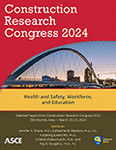Assessing Usability of Construction Safety Culture and Climate Framework: A Crucial Method for Advancing Construction Safety
Publication: Construction Research Congress 2024
ABSTRACT
The construction industry has long struggled with safety performance, with many concerns surrounding the industry’s ability to maintain high levels of safety. One effective approach to improve safety performance is through the use of construction safety culture and climate frameworks. However, the construction industry has faced several challenges in effectively utilizing these frameworks, including confusion due to the availability of multiple frameworks and the interchangeable use of definitions. To address these challenges, a distinct and practical framework for construction safety culture and climate has recently been proposed. The present study aimed to evaluate the perceived usability of this framework. To achieve this goal, an online survey was designed and administered, resulting in 77 valid responses. The analysis of the survey responses revealed that the participants generally perceived the framework’s concepts positively. However, some aspects of the framework require improvement to enhance its usability further. The study’s findings highlight the importance of adopting effective safety culture and climate frameworks in the construction industry and the need for ongoing evaluation and improvement to ensure their relevance and efficacy. As such, this research can contribute to improving the overall safety performance in the construction industry.
Get full access to this article
View all available purchase options and get full access to this chapter.
REFERENCES
Ahamed, N. M. F., and Mariappan, M. 2023. “A study to determine human-related errors at the level of top management, Safety Supervisors & workers during the implementation of safety practices in the construction industry.” Safety Science, 162, 106081. https://doi.org/10.1016/j.ssci.2023.106081.
Al-Bayati, A. J., Albert, A., and Ford, G. 2019. “Construction Safety Culture and Climate: Satisfying the Necessity for an Industry Framework.” Practice Periodical on Structural Design and Construction. 24 (4).
Al-Bayati, A. J., Bilal, G. A., Esmaeili, B., Karakhan, A., and York, D. 2021. “Evaluating OSHA’s fatality and catastrophe investigation summaries: Arc flash focus.” Safety Science, Elsevier, 140 (105287), DOI:10.1016/j.ssci.2021.105287.
Al-Bayati, A. J., Rener, A. T., Listello, M. P., and Mohamed, M. 2023. “PPE non-compliance among construction workers: An assessment of contributing factors utilizing fuzzy theory.” Journal of Safety Research, Elsevier, https://doi.org/10.1016/j.jsr.2023.02.008.
Al-Bayati, A. J. 2021a. “Firm size influence on construction safety culture and construction safety climate.” Practice Periodical on Structural Design and Construction, 26(4). https://doi.org/10.1061/(ASCE)SC.1943-5576.0000610.
Al-Bayati, A. J. 2021b. “Impact of construction safety culture and construction safety climate on safety behavior and safety motivation.” Safety, 7(41). https://doi.org/10.3390/safety7020041.
Bangor, A., Kortum, P., and Miller, J. 2008. “An empirical evaluation of the system usability scale.” International Journal of Human-Computer Interaction, 24(6), 574–594.
Borsci, S., Federici, S., and Lauriola, M. 2009. “On the dimensionality of the System Usability Scale: a test of alternative measurement models.” Cognitive Processing, 10(3), 193–197.
Brooke, J. 1996. “SUS-A quick and dirty usability scale.” Usability evaluation in industry, 189(194), 4–7.
Deming, W. E. 1986. Out of the Crisis: Quality, Productivity and Competitive Position. Cambridge University Press.
Efremov, L. 2023. “Emotions and Attitudes Towards Safety—Relationship Between Affective Commitment and Safety Attitudes Among Construction Employees in North Macedonia.” In:, et al. Occupational and Environmental Safety and Health IV. Studies in Systems, Decision and Control, vol 449. Springer, Cham. https://doi.org/10.1007/978-3-031-12547-8-33.
Erkal, E. D., Hallowell, M. R., and Bhandari, S. 2021. “Practical assessment of potential predictors of serious injuries and fatalities in construction.” Journal of Construction Engineering and Management, 147(10). https://doi.org/10.1061/(asce)co.1943-7862.0002146.
Lewis, J. R. 2018. “The System Usability Scale: Past, Present, and Future.” Int. J. Hum. Comput. Interact., 34 (7): 577–590. https://doi.org/10.1080/10447318.2018.1455307.
McCaa, B. M. 2021. “Leadership style needed within small construction companies to optimize a safety climate.” [Order No. 28646445]. Adler University.
McKay, L., Nisselle, A., Gibbs, G., and Kothmeister, L. 2019. “The subjective usability scale (SUS) for evaluating virtual reality applications: Adapting usability testing for virtual environments.” In S. Sindakis (Ed.), Human-Centered Applications (pp. 37–62). IGI Global.
Niu, M., Leicht, R. M., and Rowlinson, S. 2017. “Developing Safety Climate Indicators in a Construction Working Environment.” Practice Periodical on Structural Design and Construction., 22 (4).
Park, M., Leahey, E., and Funk, R. J. 2023. “Papers and patents are becoming less disruptive over time.” Nature, 613, 138–144. https://doi.org/10.1038/s41586-022-05543-x.
Sauro, J., and Lewis, J. R. 2016. Quantifying the user experience: Practical statistics for user research (2nd ed.). Cambridge, MA: Morgan Kaufmann.
Schwatka, N. V., Hecker, S., and Goldenhar, L. M. 2016. “Defining and measuring safety climate: a review of the construction industry literature.” Annals of Occupational Hygiene, 60 (5): 537–550.
Zohar, D., and Hofmann, D. A. 2014. “Organizational Culture and Climate, The Oxford handbook of organizational climate and culture.” Schneider, B., and Barbera, K. M. (Eds.). New York, NY, US: Oxford University Press.
Zou, P. X. W., and Sunindijo, R. Y. 2015. Strategic Safety Management in Construction and Engineering. Wiley Blackwell.
Petitta, L., Probst, T. M., Barbaranelli, C., and Ghezzi, V. 2017. “Disentangling the roles of safety climate and safety culture: Multi-level effects on the relationship between supervisor enforcement and safety compliance.” Accident Analysis & Prevention. 99: 77–89. https://doi.org/10.1016/j.aap.2016.11.012.
Bangor, A., Kortum, P., and Miller, J. 2008. “An Empirical Evaluation of the System Usability Scale.” International Journal of Human-Computer Interaction, 24(6), 574–594. https://doi-org.ezproxy.ltu.edu/10.1080/10447310802205776.
Information & Authors
Information
Published In
History
Published online: Mar 18, 2024
ASCE Technical Topics:
- Business management
- Climates
- Construction engineering
- Construction industry
- Construction management
- Construction methods
- Engineering fundamentals
- Environmental engineering
- Information management
- Occupational safety
- Practice and Profession
- Public administration
- Public health and safety
- Safety
- Terminology and definition
Authors
Metrics & Citations
Metrics
Citations
Download citation
If you have the appropriate software installed, you can download article citation data to the citation manager of your choice. Simply select your manager software from the list below and click Download.
